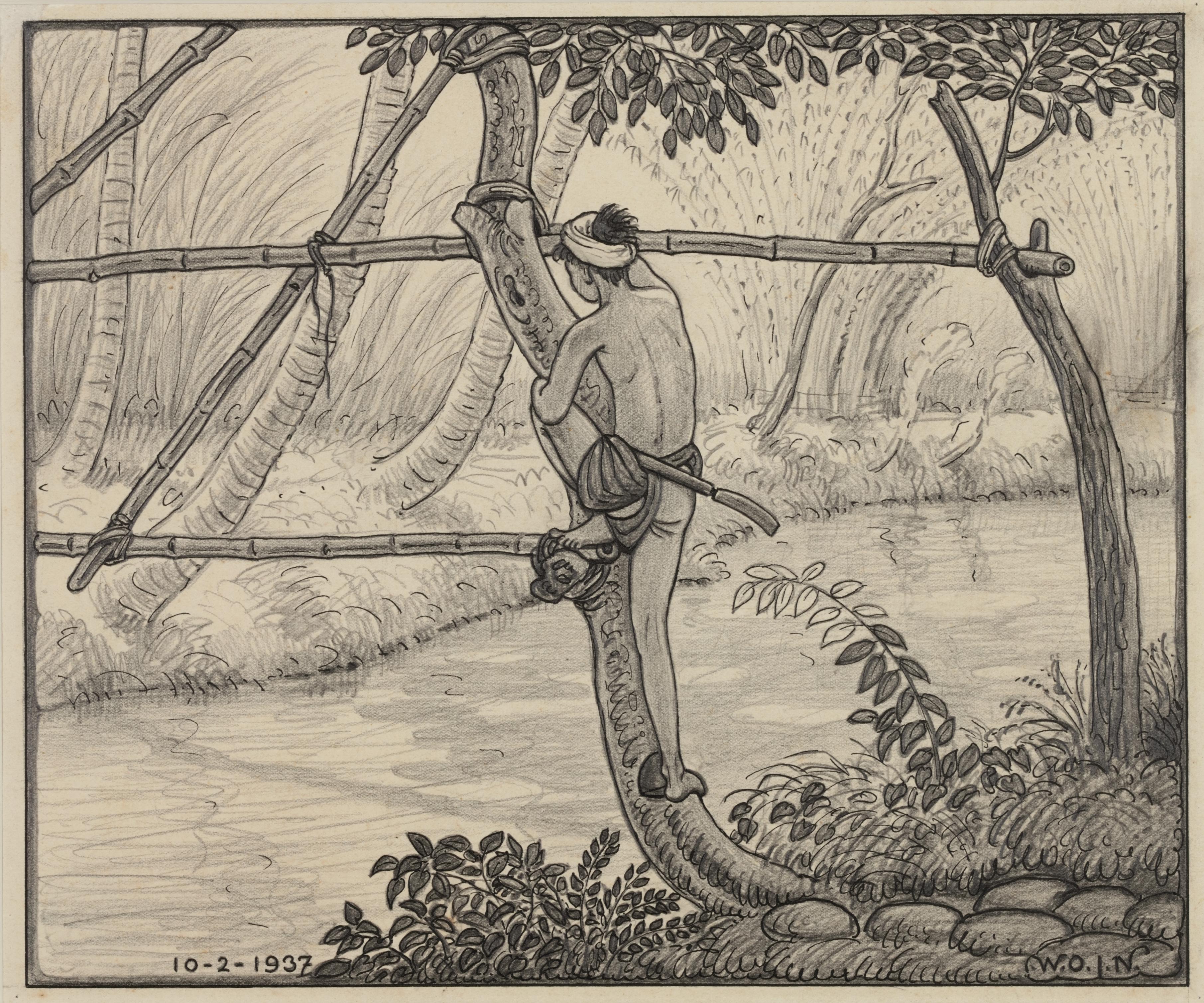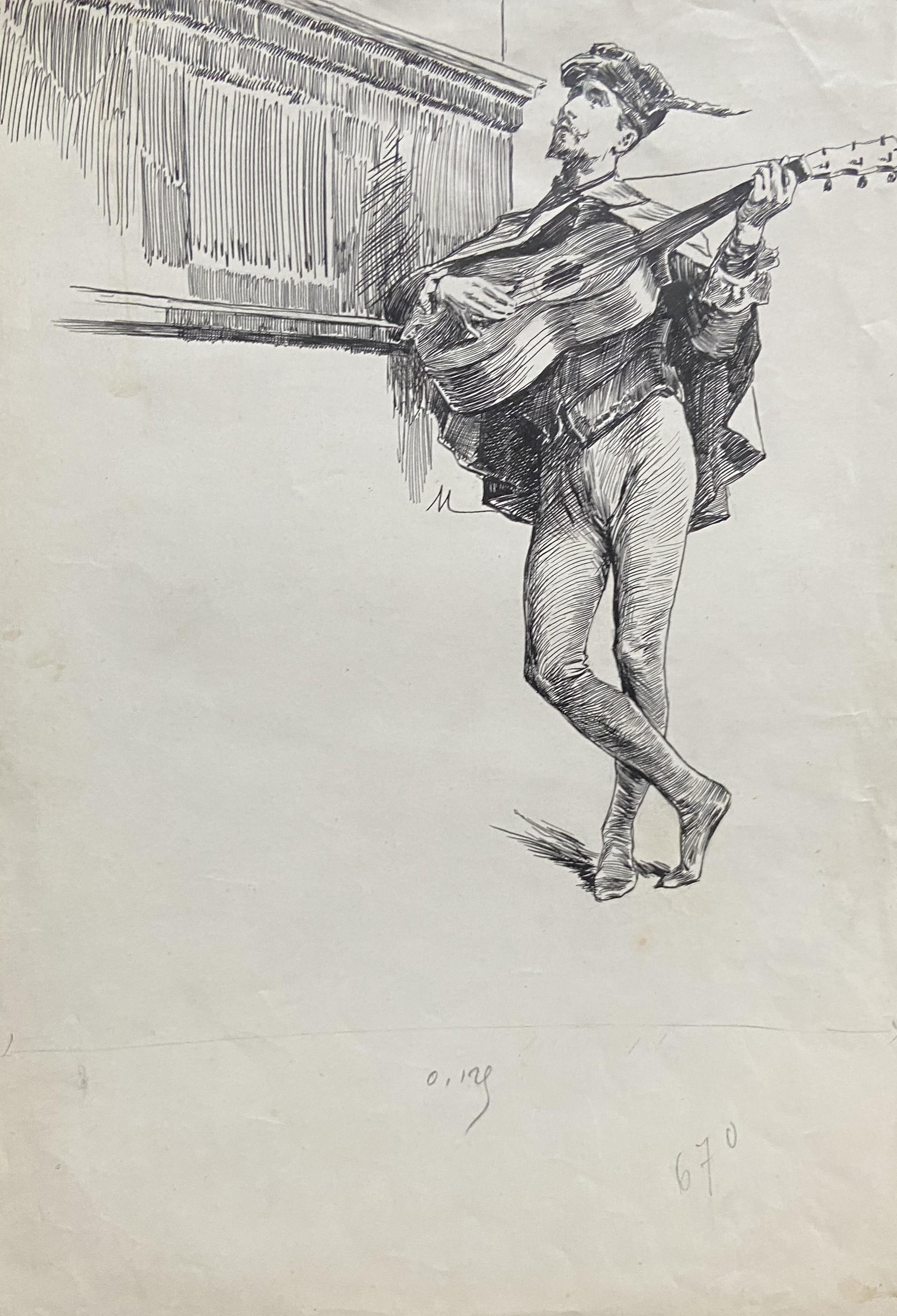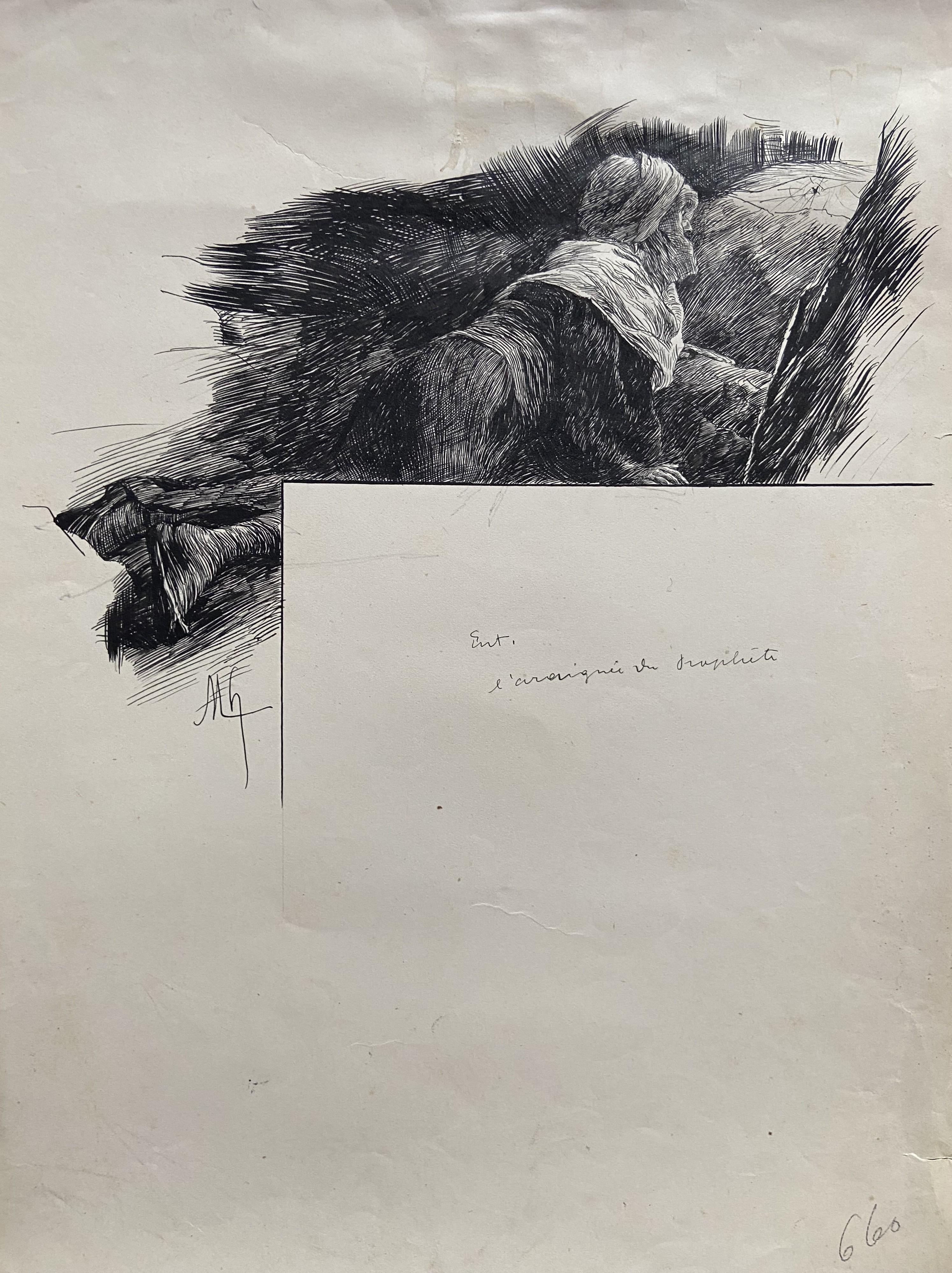Items Similar to Felician Myrbach (1853-1940) The Musketeers, original drawing
Video Loading
Want more images or videos?
Request additional images or videos from the seller
1 of 13
Felician MyrbachFelician Myrbach (1853-1940) The Musketeers, original drawingcirca 1895
circa 1895
About the Item
Felician Myrbach (1853-1940)
The Musketeers
bears the monogram "M" on the lower left
Ink and pencil on paper
26,7 x 23,7 cm
in good condition,
In a modern frame : 30 x 27 cm
It is probably an illustration project for François Coppée's poem "Duel de Raffinés." ( Duel of the refined)
It tells how two gentlemen argue about the colour of hair they prefer in women, blond or brunette, and end up fighting a duel.
As always with the great illustrator Myrbach, the illustration is perfectly in keeping with the text, which is what makes it possible to identify it here.
He leaves the space to be occupied by the text blank on the sheet and arranges his composition accordingly. It is interesting to see the artist imagine his drawing with this constraint.
Felician Myrbach (also Felicien de Myrbach, Felician von Myrbach, from 1919 Freiherr von Rheinfeld) was born on 9 February 1853 in Zalishchyky, he died 14 January 1940 in Klagenfurt
He was an Austrian painter, graphic designer and illustrator. He was a founding member of the Vienna Secession and the director of the Applied Arts School in Vienna (now the University of Applied Arts Vienna), and was instrumental in the creation of the Wiener Werkstätte.
Myrbach's father was Franz Myrbach (1818–1882), the Administrator of Bukovina in 1865–70. His older brother Franz Xaver (1850–1919) was an economist and professor at the University of Innsbruck. He attended the Theresian Military Academy in 1868–71, graduating as a Leutnant, then at the Academy of Fine Arts, Vienna under August Eisenmenger. In 1875, he joined the 19th Feldjäger Battalion, and in 1877 became an Oberleutnant in the Military Geographic Institute, then, after campaigning in Bosnia in 1878, he taught drawing at the Infantry Cadet School in Vienna. He continued his artistic studies under C R Huber. In 1881, he went on military leave and moved to Paris, retiring totally from the military in 1884 as a Hauptmann, 2nd Class. He stayed in Paris until 1897, working as an illustrator, including illustrating the works of Alphonse Daudet, Victor Hugo and Jules Verne.
Myrbach was a founding member of the Vienna Secession in 1897. In the same year, he became the a professor of the Applied Arts School at the Museum of Art and Industry; Arthur von Scala, another reformer Modernist, was made head of the Museum. In 1889, Myrbach became the director of the school. He brought an enthusiastic Modernist attitude and encouraged an integration between art, design and production. He added Koloman Moser and Josef Hoffmann to the staff, amongst other Secession artists. This would lead to the foundation of the Wiener Werkstätte in 1903. Myrbach leant more towards an aesthetic approach than von Scala, but both worked together to bring about their combined vision of successful, popular Austrian applied art. Myrbach was a voice for reform towards Modernist ideals in the School, which was started 1899 with the support of Alfred Roller, and completed by 1901.The reform of the school has been described as his "lasting merit".
Ludwig Hevesi called Myrbach "probably the best [illustrator] in Vienna", partially for his work (with Moser) in the Secession magazine Ver Sacrum.
Myrbach visited America on a state-funded study trip in 1904, part of which was to represent the Applied Arts School at the 1904 World's Fair in St Louis; from California, he submitted his resignation to the school due to ill health. He moved abroad in 1905, first returning to Paris and providing illustrations for Hachette, and then from 1914 living in Spain, mainly in Barcelona but also spent time in Bilbao. He returned to Austria in 1936.
Myrbach created many scenes of military life, as well as bucolic pictures of farmers, horses and forests; as well, his work showed touches of Orientalism.
- Creator:Felician Myrbach (1853 - 1940)
- Creation Year:circa 1895
- Dimensions:Height: 10.52 in (26.7 cm)Width: 9.34 in (23.7 cm)
- Medium:
- Movement & Style:
- Period:
- Condition:
- Gallery Location:Paris, FR
- Reference Number:
About the Seller
5.0
Platinum Seller
These expertly vetted sellers are 1stDibs' most experienced sellers and are rated highest by our customers.
Established in 2018
1stDibs seller since 2019
210 sales on 1stDibs
Typical response time: <1 hour
- ShippingRetrieving quote...Ships From: Paris, France
- Return PolicyA return for this item may be initiated within 14 days of delivery.
More From This SellerView All
- Felician Myrbach (1853-1940) Pour Guitare solo, original drawingBy Felician MyrbachLocated in Paris, FRFelician Myrbach (1853-1940) Pour Guitare solo, For Solo Guitar bears the monogram "M" in the middle left, titled in lower left Ink on paper 29,8 x 18,8 cm in good condition, traces...Category
1890s Art Nouveau Figurative Drawings and Watercolors
MaterialsInk
- Felician Myrbach (1853-1940) L'Araignée du Prophète, original drawingBy Felician MyrbachLocated in Paris, FRFelician Myrbach (1853-1940) L'Araignée du Prophète, the spider of the Prophet bears the monogram "Mb" on the middle left, titled in the middle Ink on paper 31,8 x 21.9 cm in quite ...Category
1890s Art Nouveau Figurative Drawings and Watercolors
MaterialsInk
- Felician Myrbach (1853-1940) Le Cadeau de Sahagun, original dawingBy Felician MyrbachLocated in Paris, FRFelician Myrbach (1853-1940) Le Cadeau de Sahagun, The Gift of Sahagun bears the monogram "M" on the lower left, titled on the lower left Ink on paper 29,8 x 18.7 cm In a modern fra...Category
1890s Art Nouveau Figurative Drawings and Watercolors
MaterialsInk
- Felician Myrbach (1853-1940) Poèmes magyarsBy Felician MyrbachLocated in Paris, FRFelician Myrbach (1853-1940) Poèmes magyars, Magyar poems bears the monogram "M" on the lower left, titled in the upper right Ink on paper 29,8 x 19,8 cm in good condition, the sheet is slightly yellowed In a modern frame : 33 x 23 cm This is an illustration project by Felician Myrbach for François Coppée's work, "Poèmes magyars". He leaves the space to be occupied by the text blank on the sheet and arranges his composition accordingly. It is interesting to see the artist imagine his drawing with this constraint. Felician Myrbach (also Felicien de Myrbach, Felician von Myrbach, from 1919 Freiherr von Rheinfeld) was born on 9 February 1853 in Zalishchyky, he died 14 January 1940 in Klagenfurt He was an Austrian painter, graphic designer and illustrator. He was a founding member of the Vienna Secession and the director of the Applied Arts School in Vienna (now the University of Applied Arts Vienna), and was instrumental in the creation of the Wiener Werkstätte. Myrbach's father was Franz Myrbach (1818–1882), the Administrator of Bukovina in 1865–70. His older brother Franz Xaver (1850–1919) was an economist and professor at the University of Innsbruck. He attended the Theresian Military Academy in 1868–71, graduating as a Leutnant, then at the Academy of Fine Arts, Vienna under August Eisenmenger. In 1875, he joined the 19th Feldjäger Battalion, and in 1877 became an Oberleutnant in the Military Geographic Institute, then, after campaigning in Bosnia in 1878, he taught drawing at the Infantry Cadet School in Vienna. He continued his artistic studies under C R Huber. In 1881, he went on military leave and moved to Paris, retiring totally from the military in 1884 as a Hauptmann, 2nd Class. He stayed in Paris until 1897, working as an illustrator, including illustrating the works of Alphonse Daudet, Victor Hugo and Jules Verne. Myrbach was a founding member of the Vienna Secession in 1897. In the same year, he became the a professor of the Applied Arts School at the Museum of Art and Industry; Arthur von Scala, another reformer Modernist, was made head of the Museum. In 1889, Myrbach became the director of the school. He brought an enthusiastic Modernist attitude and encouraged an integration between art, design and production. He added Koloman Moser and Josef Hoffmann to the staff, amongst other Secession artists. This would lead to the foundation of the Wiener Werkstätte in 1903. Myrbach leant more towards an aesthetic approach than von Scala, but both worked together to bring about their combined vision of successful, popular Austrian applied art. Myrbach was a voice for reform towards Modernist ideals in the School, which was started 1899 with the support of Alfred Roller, and completed by 1901.The reform of the school has been described as his "lasting merit". Ludwig Hevesi called Myrbach "probably the best [illustrator] in Vienna", partially for his work (with Moser) in the Secession magazine Ver Sacrum. Myrbach visited America on a state-funded study trip in 1904, part of which was to represent the Applied Arts School at the 1904 World...Category
Early 1900s Art Nouveau Figurative Drawings and Watercolors
MaterialsInk
- France early 20th century, Head of a faun, original drawingLocated in Paris, FRFrance, early 20th century Head of a faun bears a monogram "P H" on the lower right Pencil on paper 24.5 x 13 cm In a period frame (in good condition except a small loss on the upper...Category
1910s Art Nouveau Portrait Drawings and Watercolors
MaterialsCarbon Pencil
- Jules Cheret (1836-1932) La Confidence, 1909, drawing signedBy Jules ChéretLocated in Paris, FRJules Cheret (1836-1932) La Confidence (The confidence) 1909 signed and dated in the lower right Charcoal and heightenings of white chalk 22.7 x 22.7 cm Framed under glass : 33.8 x...Category
Early 1900s Art Nouveau Figurative Drawings and Watercolors
MaterialsChalk, Charcoal
You May Also Like
- Statue of Vishnu Garuda, Bali, 1904Located in Amsterdam, NLStatue of Vishnu Garuda, Bali, 1904 Signed with initials Pencil and ink on paper, 21.4 x 21.3 cm Literature: Bruce W. Carpenter, W.O.J. Nieuwenkamp. First European Artist in Bali,...Category
Early 1900s Art Nouveau Landscape Drawings and Watercolors
MaterialsPaper, Pencil, India Ink
- Borobudur, Java, Indonesia (1937)Located in Amsterdam, NLGraveyard with in the background the Borobudur, 1937 Signed with initials and dated bottom left Pencil and ink on paper, 33 x 29 cm In ebonized frame with white mount Literature: ...Category
1930s Art Nouveau Landscape Drawings and Watercolors
MaterialsPaper, Ink, Graphite
- Wobbly bridge, Tabanan, Bali, 1937Located in Amsterdam, NLWobbly bridge, Tabanan, Bali, 1937 Signed with initials bottom right and dated, bottom left Pencil and ink on paper, 22 x 26.3 cm In ebonized frame with white mount Willem Otto Wi...Category
1930s Art Nouveau Landscape Drawings and Watercolors
MaterialsPaper, India Ink, Pencil
- "Medieval Thoughts, Prague, " Alphonse Mucha, Czech Art Nouveau IllustrationBy Alphonse MuchaLocated in New York, NYAlphonse Mucha (Czech, 1860 - 1939) Medieval Thoughts, circa 1890 Wash, ink, and watercolor on paper 11 x 9 inches Signed lower right Provenance: Phillips New York, 19th and 20th ce...Category
1890s Art Nouveau Figurative Drawings and Watercolors
MaterialsPaper, Ink, Watercolor
- Fairies among the Lily Pads - Female Illustrator FantasyLocated in Miami, FLA turn-of-the-century fantasy illustration by female illustrator May Audubon Post features a charming fairy with expanded wings resting on Lilly s...Category
Early 1900s Art Nouveau Figurative Drawings and Watercolors
MaterialsPaper, Ink, Watercolor
- 'Princess Herminie and the Tapestry Prince - Female IllustratorLocated in Miami, FLAn original pen and ink by Barbara Macdonald 1892-1969, that was published on page 70 of the 1922 book, 'Princess Herminie and the Tapestry Prince,' written by Lee Ivatt. The second ...Category
1920s Art Nouveau Figurative Drawings and Watercolors
MaterialsInk, Pen
Recently Viewed
View AllMore Ways To Browse
Antique Hair Rollers
Ludwig Moser
Marguerite Callet-Carcano On Sale
Maurice Berdon On Sale
Augusta Hoffman Studio
Augusta Hoffman
Bar Cart Nyc
Blue Milk Paint Farm Table
Bo Bartlett On Sale
Broncia Koller
Bror Julius Olsson Nordfeldt On Sale
Buford Crossland
C. Harry Allis On Sale
Cecil Wray Goodchild
Charles Paul Gruppe On Sale
Chinese Figurative Rug
Claudio Bravo Pencil
Concetta Scaravaglione





